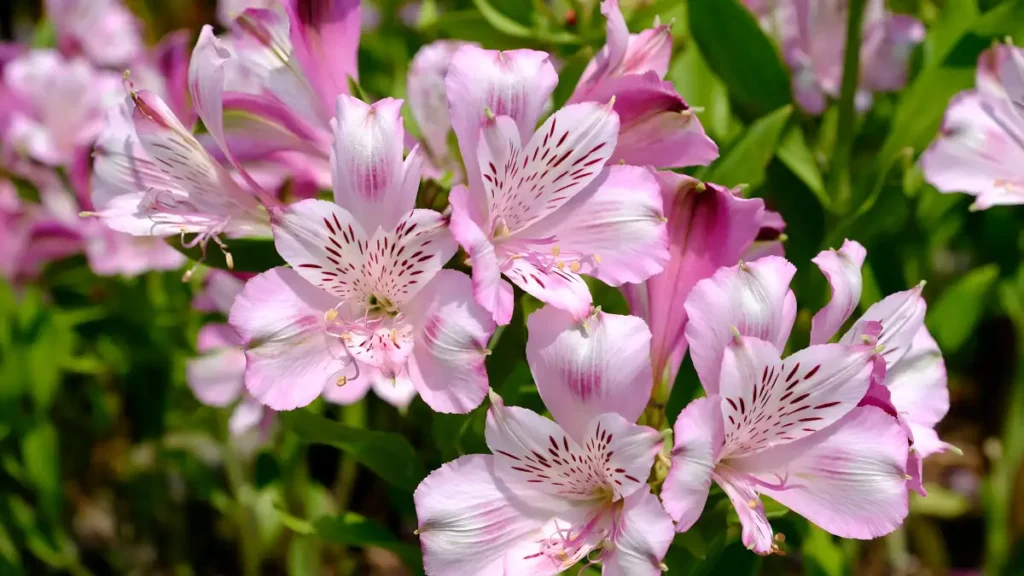The Peruvian Lily (Alstroemeria), often known as the Lily of the Incas, is a breathtaking flower with brilliant colors and an exotic appearance. Aside from its beauty, this flower has great meaning and symbolism. This article will teach you everything you need to know about Peruvian Lilies, including their significance, growing tips, and maintenance requirements.
Peruvian lilies are known for their size, which ranges from 20 inches to slightly over three feet, and their spreading roots, which typically take over an area. Although they require some shelter from the hot afternoon sun, these plants love full light, rich, well-draining soil, and around one inch of water per week.
Peruvian lily meaning & symbolism:
Meaning of Peruvian lily
Peruvian lilies are frequently linked to close relationships and friendships. They are the ideal present for friends and loved ones because of their delicate yet strong nature, which symbolizes unwavering love and dedication.
Symbolism of Peruvian lily
The twisted leaves represent friendship and affection, and the stout stems represent strength. The rich growth and vivid hues stand for prosperity and good fortune. Constant blooms represent resilience and constructive progress. Pink symbolizes affection, passion, happiness, joy, purity, spirituality, love, passion, and majesty, while yellow represents happiness and joy, white represents purity, red represents love and passion, and purple represents elegance.
The ideal climate for Peruvian lily flower growth:
Peruvian lilies like mild to warm climes and grow well in USDA hardiness zones 7–10. Fertile soil that drains well and is high in organic matter is ideal for Peruvian lilies. The optimal pH range is 6.0–7.0, which is slightly acidic to neutral. Add compost or well-rotted manure to the soil to provide it with vital nutrients.
For best growth, these flowers need full sun to partial shade. Partial shade is advised in areas with strong sunlight to avoid scorching the leaves, while full sun is ideal in milder climates. Temperatures between 60°F and 75°F (15°C and 24°C) are ideal, and frost protection is essential.
While regular moisture is necessary, excessive irrigation can cause root rot. Every week, give the soil a deep soaking, letting it dry out a little in between. Increase the frequency during warmer weather, but stay away from soggy circumstances.
Planting and propagating the Peruvian Lily:
Plant bulbs in the spring or fall, spacing them 12-18 inches apart. Dig holes 2-3 inches deep and place bulbs with the pointed ends facing up. Cover with soil and water thoroughly.
The Peruvian lily, native to Chile and Argentina, can be propagated through seed sprouting or root separation and can be displayed in a vase to limit their spread and prevent receding.
To split a plant, use pruners to remove dead or green growth up to six inches. Dig a few inches around the clump, avoiding harm to other plants. Brush off excess dirt after lifting the entire cluster, avoiding damage to fragile roots. Carefully break apart clumps, which should have three to five tubers. Replant the garden immediately after digging a shallow trench, cover tubers with two inches of earth, and place them atop a small pile of dirt.
Peruvian Lily care and pruning:
In the spring, fertilize Peruvian lilies using a balanced, slow-release fertilizer. To promote bright flowers during the growth season, add a liquid fertilizer every four to six weeks. Apply compost or organic mulch, use high-potassium fertilizer during blooming, and steer clear of too much nitrogen, which can encourage the growth of foliage but not flowers, to improve soil fertility.
Trim Peruvian lilies after flowering to prevent seed production, remove less productive stems from overspreading plants, and trim foliage in late October to prepare for winter dormancy.
Aphids, spider mites, and slugs are common pests. For control, use neem oil or organic insecticidal soap. Leaf spots and botrytis blight are possible; to reduce hazards, make sure there is adequate air circulation and refrain from watering from above.
Garden design ideas using Peruvian lilies:
Use Peruvian lilies in mixed borders, rock gardens, or as edging plants. Their bright colors match roses, daisies, and lavender. Plant in masses or drifts to provide a striking visual impact.
Conclusion:
The Peruvian Lily (Alstroemeria) is a beautiful, symbolic, and low-maintenance flower that offers gardeners spectacular, long-lasting flowers. By following the care, planting, and maintenance recommendations in this guide, you can ensure that your lilies thrive year after year, adding beauty and meaning to your garden and floral arrangements.
Certainly! If you’d like to learn more, please consider following our WhatsApp Channel, Facebook, Instagram, YouTube, Twitter, and Pinterest.
A frequently asked questions:
Q1: Are Peruvian lilies toxic to humans?
A1: Peruvian lilies (Alstroemeria) are somewhat poisonous to humans and contain tulipalin A, which can cause skin irritation. Consuming large amounts may cause intestinal pain, but they are not very toxic.
Q2: What is another name for a Peruvian lily?
A2: The Peruvian lily is also known as Alstroemeria. It is also known as the Lily of the Incas.
Q3: Do Peruvian lilies like sun or shade?
A3: Peruvian lilies prefer full sun over partial shade. They flourish in at least 6 hours of sunlight and benefit from some afternoon shade in hot areas.
Q4: What is the difference between Peruvian lily and Asiatic Lily?
A4: Peruvian lilies (Alstroemeria) have smaller, trumpet-shaped flowers with a more delicate, wild appearance and are not true lilies, whereas Asiatic lilies (Lilium) have larger, showy blooms with a strong smell and are grown from true lily bulb. Furthermore, Asiatic lilies are more harmful to pets than Peruvian lilies.

